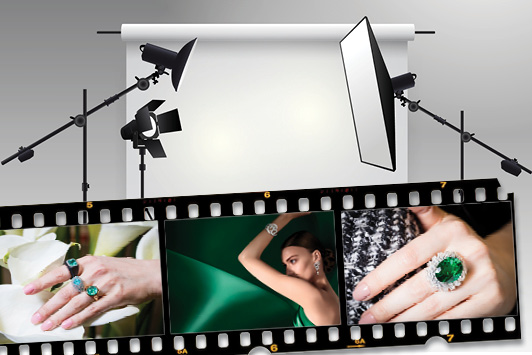
Modern retailers know the formula for desirable, attractive photography: The brighter, bolder and more colorful the image, the more appealing it is. To make that happen, it’s common practice to enhance images with photo-editing technology. In the diamond industry, though, minute variations in a stone’s color, clarity and brightness can mean gargantuan differences in value — so even the slightest edit may be perceived as a misrepresentation of the product.
In a world where consumers have become desensitized to heightened versions of reality, how can diamond retailers present the best-looking photos of their merchandise without compromising on business ethics? The key to navigating this ambiguous territory is twofold: working to create quality images to begin with, and being transparent about accurate representation.
No substitute for skill
Ideally, you want to show your products in their best light, both literally and metaphorically. Digital enhancement is often unnecessary if you are using the full arsenal of tools at your disposal — the most effective of which is an excellent jewelry photographer.
Leo Bieber has earned a reputation as one of the most skilled photographers in the industry.
“It’s all about honesty and clarity,” he says. “It’s cheating to use Photoshop to do the work which clever lighting can achieve; all of this can be done without any editing. Erasing an inclusion with software is a misrepresentation of a diamond.”
Even the greatest editor in the world and the most cutting-edge software cannot compensate for poor photography; a social media manager with an iPhone, even less so. Instagram’s native editing software appears as you upload every image or video, and while this primitive style of editing can prove tempting for some brands, it can be too powerful, overcorrecting to the point of inaccuracy.
Photoshop is more sophisticated. In the hands of specialists, it can be the right tool for the job, achieving more subtle corrections that don’t alter the image unduly. However, since it’s widely available to the public, many Photoshop users are unskilled — and in those cases, it can be as problematic as any other software.
Setting standards
The most powerful tool for maintaining transparency is education — meaning reiteration of fair and best practices in our industry. To date, the Federal Trade Commission (FTC) has outlined no guidelines or rulings on jewelry imagery. Though it has set out clear rules for terminology, it’s unrealistic to assume that only words can mislead — especially in this age of visual media and online purchasing.
Of course, setting standards for fair trading when it comes to ephemeral images and videos is complex. But at a basic level, removing inclusions, improving clarity, brightening a diamond and enhancing color saturation are practices to avoid.
In addition, stating your commitment to ethical and accurate representation in your product descriptions and as part of your brand copy is a strategy that encourages trust. Strict, consistent standards of practice regarding imagery should be a pillar of your marketing. The more consumers can trust our industry, the more we all benefit.
Images: Simon Martner; Graff; ShutterstockArticle from the Rapaport Magazine - October 2019. To subscribe click here.